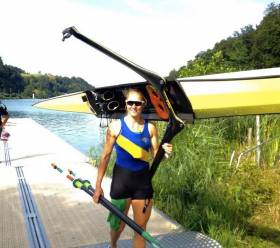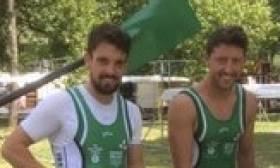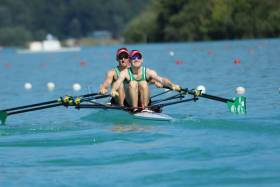Displaying items by tag: Lucerne
Puspure Wins Semi-Final at World Cup Regatta in Lucerne
#Rowing: Sanita Puspure won her semi-final of the single sculls at the World Cup Regatta in Lucerne with a dominant performance. Annekatrin Thiele of Germany disputed the lead in the first quarter, but Puspure led by the 1,000 metre mark and was clear by over four seconds at the finish. Austria’s Magdalena Lobnig pushed past Thiele to take second.
World Cup Regatta, Lucerne, Day Two (Irish interest; selected results)
Men
Pair – A/B Semi-Final One (First Three to A Final; rest to B Final): 1 Serbia 6:33.87, 2 Spain 6:36.65, 3 Britain One 6:38.90; 4 Ireland (M O’Donovan, S O’Driscoll) 6:42.02.
D Final (Places 19 to 24): 1 Poland 6:40.95; 5 Ireland (P Boomer, A Harrington) 6:53.83.
Single Sculls – C Final (Places 13 to 18): 1 Australia 6:58.52, 2 Argentina 6:59.65, 3 Ireland (P Doyle) 7:00.39.
Women
Pair - Repechage (First Two to A Final; rest to B Final): 1 Australia 7:18.62, 2 China One 7:19.86; 4 Ireland (A Keogh, T Hanlon) 7:29.63.
Double – Semi-Final (First Three to A Final; rest to B Final): 1 New Zealand 6:53.91, 2 Canada 6:57.71, 3 Netherlands 6:58.57; 4 Ireland (A Crowley, M Dukarska) 7:06.42.
Single Sculls – Semi-Final (First Three to A Final; rest to B Final): 1 Ireland (S Puspure) 7:39.59, 2 Austria (M Lobnig) 7:43.68, 3 Germany (A Thiele) 7:45.59.
Doyle Third After Leading C Final at Lucerne World Cup
#Rowing: Philip Doyle finished third in the C Final of the men’s single sculls at the World Cup Regatta in Lucerne this morning. The Queen’s University man led until the final quarter when Campbell Watts of Australia and Brian Rosso of Argentina got past him to take first and second. Doyle places 15th in his first regatta at this level in one of the toughest disciplines.
Earlier, Patrick Boomer and Andy Harrington had taken fifth in the D Final of the pairs.
World Cup Regatta, Lucerne, Day Two (Irish interest; selected results)
Men
Pair – D Final (Places 19 to 24): 1 Poland 6:40.95; 5 Ireland (P Boomer, A Harrington) 6:53.83.
Single Sculls – C Final (Places 13 to 18): 1 Australia 6:58.52, 2 Argentina 6:59.65, 3 Ireland (P Doyle) 7:00.39.
O'Driscoll and O'Donovan Nail Place in Top Twelve at Lucerne
#Rowing: Shane O’Driscoll and Mark O’Donovan took a fine second place behind France One in the quarter-final of the men’s pairs at the World Cup Regatta in Lucerne today and secured their place in the A/B Semi-Finals. The Skibbereen men moved from fourth to second as the race progressed, ensuring that they would stay in the hunt for the top spots in this heavyweight event. The second Ireland pair of Patrick Boomer and Andy Harrington finished sixth in the same quarter-final.
World Cup Regatta, Lucerne, Day One (Irish interest; selected results)
Men
Pair – Heat Two (First Four to Quarter-Final; rest to Quarter-Final or E Final): 1 Spain 6:40.29; 3 Ireland Two (P Boomer, P Harrington) 6:45.74
Heat Six (First Three to Quarter-Final; rest to Quarter-Final or E Final): 1 Croatia 6:37.66, 2 Ireland One (M O’Donovan, S O’Driscoll) 6:40.95. Quarter-Final Two (First Three to A/B Semi-Finals; Fourth to C Final; rest to Final C or D): France One 6:38.22, 2 Ireland One (O’Donovan, O’Driscoll) 6:40.12; 6 Ireland (Boomer, Harrington) 6:54.89
Lightweight Double Sculls – Heat One (First two to A/B Semi-Finals; rest to Repechage): 1 Ireland (G O’Donovan, P O’Donovan) 6:17.43, 2 Austria 6:17.79; 3 Poland 6:17.91.
Single Sculls – Heat One (First Four to Quarter-Final; rest to Quarter-Final or E Final): 1 New Zealand (M Drysdale) 6:52.98; 3 Ireland (P Doyle) 6:55.18.
Women
Pair – Heat Two (First to A Final; rest to Repechage): 1 Canada 7:13.98; 6 Ireland (A Keogh, T Hanlon) 7:32.49.
Double Sculls – Heat Two (First Three to A/B Semi-Finals; rest to Repechages): 1 United States 6:58.58, 2 Ireland (A Crowley, M Dukarska) 7:03.05.
Single Sculls – Heat One (First to A/B Semi-Final; rest to Repechages): 1 Ireland (S Puspure) 7:26.51; 2 United States 7:40.98.
#Rowing: Paul O’Donovan and Gary O’Donovan won their heat to qualify directly for the semi-finals at the World Cup Regatta in Lucerne. The Ireland lightweight double scull took the lead from the start. They led Poland at halfway, but the Poles, who beat Ireland in the first World Cup in Belgrade, then took over. Austria pushed into the top three and these boats fought it out for two places. Ireland showed they had the speed in the dash to the line – and it was Poland who lost out, taking third.
Philip Doyle qualified for the quarter-finals of the single sculls with third place in his heat. Mahe Drysdale, the Olympic champion, was the likely winner, but Doyle led through the 500 metre mark. The big New Zealander took over and won. Sverri Nielsen of Denmark took second and Doyle was just behind him.
World Cup Regatta, Lucerne, Day One (Irish interest; selected results)
Men
Pair – Heat Two (First Four to Quarter-Final; rest to Quarter-Final or E Final): 1 Spain 6:40.29; 3 Ireland Two (P Boomer, P Harrington) 6:45.74
Heat Six (First Three to Quarter-Final; rest to Quarter-Final or E Final): 1 Croatia 6:37.66, 2 Ireland One (M O’Donovan, S O’Driscoll) 6:40.95.
Lightweight Double Sculls – Heat One (First two to A/B Semi-Finals; rest to Repechage): 1 Ireland (G O’Donovan, P O’Donovan) 6:17.43, 2 Austria 6:17.79; 3 Poland 6:17.91.
Single Sculls – Heat One (First Four to Quarter-Final; rest to Quarter-Final or E Final): 1 New Zealand (M Drysdale) 6:52.98; 3 Ireland (P Doyle) 6:55.18.
Women
Pair – Heat Two (First to A Final; rest to Repechage): 1 Canada 7:13.98; 6 Ireland (A Keogh, T Hanlon) 7:32.49.
Double Sculls – Heat Two (First Three to A/B Semi-Finals; rest to Repechages): 1 United States 6:58.58, 2 Ireland (A Crowley, M Dukarska) 7:03.05.
Single Sculls – Heat One (First to A/B Semi-Final; rest to Repechages): 1 Ireland (S Puspure) 7:26.51; 2 United States 7:40.98.
#Rowing: Sanita Puspure won her heat of the single sculls impressively to qualify directly for the semi-final of the World Cup Regatta in Lucerne. Puspure was tested somewhat to 1500 metres by Kara Kohler of the United States, but only the winner would avoid the repechage, and the Ireland sculler built her lead. Kohler slipped back and settled for second. Three other Ireland crews had already hit the mark in their heats.
World Cup Regatta, Lucerne, Day One (Irish interest; selected results)
Men
Pair – Heat Two (First Four to Quarter-Final; rest to Quarter-Final or E Final): 1 Spain 6:40.29; 3 Ireland Two (P Boomer, P Harrington) 6:45.74
Heat Six (First Three to Quarter-Final; rest to Quarter-Final or E Final): 1 Croatia 6:37.66, 2 Ireland One (M O’Donovan, S O’Driscoll) 6:40.95.
Women
Pair – Heat Two (First to A Final; rest to Repechage): 1 Canada 7:13.98; 6 Ireland (A Keogh, T Hanlon) 7:32.49.
Double Sculls – Heat Two (First Three to A/B Semi-Finals; rest to Repechages): 1 United States 6:58.58, 2 Ireland (A Crowley, M Dukarska) 7:03.05.
Single Sculls – Heat One (First to A/B Semi-Final; rest to Repechages): 1 Ireland (S Puspure) 7:26.51; 2 United States 7:40.98.
#Rowing: Three of the four Ireland boats in early action at the World Cup Regatta in Lucerne qualified directly from their heats and avoided repechage action.
Shane O’Driscoll and Mark O’Donovan took second place in their heat of the men’s pairs and secured a place in the quarter-finals. The world lightweight champions came up against the outstanding Sinkovic brothers from Croatia, who won the race with a sparkling performance. The key battle behind them was not to finish last. Brazil and Australia battled with Ireland, but O’Donovan and O’Driscoll moved away from both, collared second place and held on to it.
Patrick Boomer and Andy Harrington secured third place in their heat. Their qualification looked in doubt as they battled with Croatia at the back of the field. But the big Ireland crew found speed when they needed it. They produced the fastest final quarter, and left the Croats behind them. China faded badly and took the last place.
The women’s double of Monika Dukarska and Aileen Crowley qualified directly for the A/B Semi-Finals with a solid second place. The United States crew of Megan O’Leary and Ellen Tomek were convincing winners, while Dukarska and Crowley held on to second despite a late charge by China, who pushed Switzerland into the repechage.
In the women’s pair, the new crew of Aifric Keogh and Tara Hanlon finished sixth in their heat and are set for a repechage.
World Cup Regatta, Lucerne, Day One (Irish interest; selected results)
Men
Pair – Heat Two (First Four to Quarter-Final; rest to Quarter-Final or E Final): 1 Spain 6:40.29; 3 Ireland Two (P Boomer, P Harrington) 6:45.74
Heat Six (First Three to Quarter-Final; rest to Quarter-Final or E Final): 1 Croatia 6:37.66, 2 Ireland One (M O’Donovan, S O’Driscoll) 6:40.95.
Women
Pair – Heat Two (First to A Final; rest to Repechage): 1 Canada 7:13.98; 6 Ireland (A Keogh, T Hanlon) 7:32.49.
Double Sculls – Heat Two (First Three to A/B Semi-Finals; rest to Repechages): 1 United States 6:58.58, 2 Ireland (A Crowley, M Dukarska) 7:03.05.
Bronze for O'Donovans at World Cup Rowing in Lucerne
#Rowing: Ireland’s Paul and Gary O’Donovan took bronze at the World Cup Regatta in Lucerne today. Olympic champions France, as has been the pattern this season, took the lead early and never relinquished it. Italy chased them all the way and took silver.
The Ireland lightweight double was in touch from early on and established themselves firmly in third coming to the line, ahead of Belgium and Greece.
World Cup Regatta, Lucerne, Day Three (Irish interest)
Men
Lightweight Double Sculls – A Final: 1 France 6:12.96, 2 Italy 6:15.43, 3 Ireland (G O’Donovan, P O’Donovan) 6:18.15; 4 Belgium 6:19.30, 5 Greece 6:19.95, 6 Czech Republic 6:21.34.
Women
Quadruple Sculls – A Final: 5 Britain (3 H Nixon) 6:29.50.
Single Sculls – B Final: 1 Ukraine 7:39.55, 2 New Zealand 7:41.55, 3 Ireland One (S Puspure) 7:42.23, 4 Denmark One 7:42.26, 5 Belarus 7:42.89, 6 Ireland Two (M Dukarska) 7:56.07.
Puspure Takes Third in B Final at Lucerne Rowing
#Rowing: Sanita Puspure took third in the B Final of the women’s single sculls at the World Cup Regatta in Lucerne, ninth overall, while Monika Dukarska was three places further back, in sixth (12th overall). Puspure was part of a five-boat sprint finish, and she showed good speed to finish ahead of Fie-Udby Erichsen of Denmark and Ekaterina Karsten of Belarus. Ahead of her was winner Diana Dymchenko of Ukraine and Hannah Osborne of New Zealand. Dukarska, who had started well, had fallen a few lengths off this leading group by the finish.
World Cup Regatta, Lucerne, Day Three (Irish interest)
Women
Single Sculls – B Final: 1 Ukraine 7:39.55, 2 New Zealand 7:41.55, 3 Ireland One (S Puspure) 7:42.23, 4 Denmark One 7:42.26, 5 Belarus 7:42.89, 6 Ireland Two (M Dukarska) 7:56.07.
#Rowing: Shane O’Driscoll and Mark O’Donovan won the A Final of the lightweight pair at the World Cup in Lucerne today. They swept past early leaders Britain in the third quarter and won well. Russia showed surprising pace late on to take silver, while Brazil took the bronze, ahead of Britain’s Sam Scrimgeour and Joel Cassells.
O’Driscoll and O’Donovan won World Cup gold in Belgrade and Poznan and are European champions thanks to their win in Racice.
World Cup Regatta, Lucerne – Day Two (Irish interest)
Men
Lightweight Pair – A Final: 1 Ireland (M O’Donovan, S O’Driscoll) 6:34.00, 2 Russia 6:36.28, 3 Brazil 6:37.50; 4 Britain 6:38.84, 5 France 6:45.94, 6 Norway 6:58.68.
Lightweight Double Sculls – Semi-Finals (First Three to A Final; rest to B Final) – Semi Final One: 1 France 6:20.57, 2 Belgium 6:24.68, 3 Greece 6:26.92.
Semi Final Two: 1 Italy 6:20.82, 2 Czech Republic 6:22.05, 3 Ireland (G O’Donovan, P O’Donovan) 6:23.75; 4 Britain 6:25.25, 5 Japan Two 6:27.84, 6 Russia 6:34.33.
Women
Single Sculls Semi-Finals (First Three to A Final; rest to B Final) – Semi Final One: 1 Austria (M Lobnig) 7:35.06, 2 Germany (A Thiele) 7:35.96, 3 Britain (V Thornley) 7:36.09; 4 Ireland One (S Puspure) 7:36.90; 6 Ireland Two (M Dukarska) 7:55.0.
O'Donovans Qualify for A Final at Lucerne World Cup
#Rowing: Paul and Gary O’Donovan qualified for the A Final of their fourth major regatta this season when they finished third in their semi-final at the World Cup in Lucerne. They reached the top stage in World Cup regattas in Belgrade and Poznan and at the European Championships.
Italy took the risky strategy of setting off very fast in the hope of leading all the way. It worked, and they won. The Czech Republic, Ireland and Russia were their main rivals until the final quarter, when, as the Russians faded in the hot conditions, the Czechs and Ireland nailed down the second and third spots. Britain’s Jamie Copus and Sam Mottram pushed to pass Ireland but could not.
World Cup Regatta, Lucerne – Day Two (Irish interest)
Men
Lightweight Double Sculls – Semi-Finals (First Three to A Final; rest to B Final) – Semi Final One: 1 France 6:20.57, 2 Belgium 6:24.68, 3 Greece 6:26.92.
Semi Final Two: 1 Italy 6:20.82, 2 Czech Republic 6:22.05, 3 Ireland (G O’Donovan, P O’Donovan) 6:23.75; 4 Britain 6:25.25, 5 Japan Two 6:27.84, 6 Russia 6:34.33.
Women
Single Sculls Semi-Finals (First Three to A Final; rest to B Final) – Semi Final One: 1 Austria (M Lobnig) 7:35.06, 2 Germany (A Thiele) 7:35.96, 3 Britain (V Thornley) 7:36.09; 4 Ireland One (S Puspure) 7:36.90; 6 Ireland Two (M Dukarska) 7:55.0.
































































